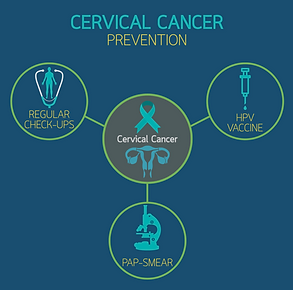What is cervical cancer ?
 Cervical cancer develops when cells grow out of control in the uterine cervix. The cervix is the lower part of the uterus (womb), connecting the uterus to the vagina. The most common type of cervical cancer is squamous cell carcinoma. Almost all cases of cervical cancer are caused by human papillomavirus (HPV). When found early during regular screening, treatment is generally effective and many people with this cancer can be cured. More advanced disease is harder to treat.
Cervical cancer develops when cells grow out of control in the uterine cervix. The cervix is the lower part of the uterus (womb), connecting the uterus to the vagina. The most common type of cervical cancer is squamous cell carcinoma. Almost all cases of cervical cancer are caused by human papillomavirus (HPV). When found early during regular screening, treatment is generally effective and many people with this cancer can be cured. More advanced disease is harder to treat.
21 REASONS TO SEE A GYNECOLOGIST BEFORE YOU TURN 21
Q&A questions and answers about cervical cancer
WHO GETS CERVICAL CANCER?
Cervical cancer is the third most common malignancy in women worldwide and is a leading cause of cancer-related death for women in developing countries. In the United States, however, cervical cancer is relatively uncommon. An estimated 13,200 new cases of cervical cancer will be diagnosed and about 4,200 women die from it this year, according to the American Cancer Society.
Cervical cancer rates in the United States have dropped by about 70 percent over the past 50 years as a result of widespread screening with Pap tests, which detect abnormal precancerous cells and allow for early treatment. Wider use of the HPV vaccine in recent years has also contributed to the decline.
Cervical cancer usually develops in midlife, with most cases occurring among women younger than 50, although more than 15 percent of cases occur in women older than 65.
This cancer is rarely seen in women younger than 20. Latina or Hispanic women are most likely to get cervical cancer, followed by African Americans, Asians and Pacific Islanders, whites and Native Americans.
WHAT ARE THE RISK FACTORS OF CERVICAL CANCER?
The main cause of cervical cancer is HPV infection. There are more than 100 types of HPV, but only a small number are linked to cancer; some other HPV types cause genital warts. About a dozen types are considered high-risk, or cancer-causing. Two types in particular, 16 and 18, are responsible for about 70 percent of all cervical cancers. Sexual contact is a common way to get HPV, but this can also occur through nonsexual skin-to-skin contact.
Risk Factors:
- smoking
- hx of chlamydia
- oral contraceptives
- family history of cervical cancer
- no access to gynecological screening.
Cervical cancer and other cancers linked to HPV infection can be prevented with vaccines. A vaccine that protects against nine HPV types is recommended for adolescents at age 11 or 12, and it is approved for women and men up to age 45. Regular HPV screening and Pap tests throughout adult life can detect abnormal changes in cervical cells, allowing for treatment to stop cancer from developing.
WHAT ARE THE SYMPTOMS OF CERVICAL CANCER?
Cervical cancer often does not cause any signs or symptoms during its early stages. Many women with cervical disease do not develop symptoms until later stages, after the cancer grows into surrounding tissues and organs, a process known as metastasis.
Symptoms that may suggest cervical cancer but could also be due to other health conditions should, and which should be checked by a doctor or nurse, include:
- Increased discharge from the vagina
- A change in the color or odor of vaginal discharge
- Vaginal bleeding between periods
- Vaginal bleeding after menopause
- Pain during sexual intercourse
- Bleeding after sex
- Difficulty urinating or loss of bladder control
HPV vaccine schedule
- HPV vaccination is recommended for preteens aged 11 to 12 years, but can be given starting at age 9.
- HPV vaccine also is recommended for everyone through age 26 years, if they are not vaccinated already.
- You should get screened for cervical cancer regularly, even if you received an HPV vaccine.